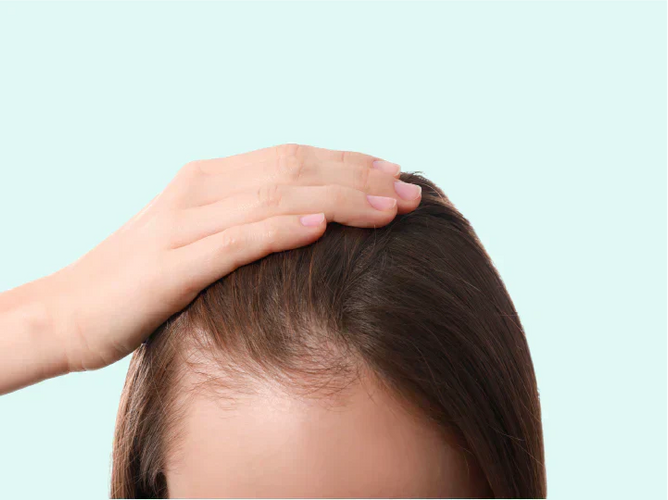It starts with a subtle itch or a warm tingling sensation on your scalp after a sunny day, nothing alarming at first. But soon, the itching intensifies, flakes appear, and your scalp feels sore to the touch. If this sounds familiar, you may be dealing with a sunburned scalp. A common yet underestimated issue that can cause real discomfort and even lead to temporary hair loss if ignored.
In this article, we’ll walk you through the key symptoms of scalp sunburn. How to distinguish them from conditions like dandruff and the most effective ways to treat and prevent further damage. Whether you’re looking to soothe the burn, stop the peeling, or protect your scalp in the future, this article gives you both immediate relief strategies and long-term care tips.
What is a sunburned scalp?
Why the scalp is vulnerable to UV rays
A sunburned scalp occurs when the skin on the scalp becomes red, painful and possibly blistered due to prolonged exposure to ultraviolet (UV) rays from the sun. The scalp is especially sensitive because it’s often exposed and has thinner skin compared to other body parts, especially in individuals with thinning or no hair.
Typical signs of sunburn on the scalp
- Sunburn symptoms may include:
- Redness
- Pain
- Inflammation
- Itching and in severe cases
- Blisters
- Skin peeling
Sweat blisters can also form as small fluid-filled bumps, making the area feel hot and painful. Hair loss may occur in more severe cases due to follicular damage. Scientific evidence shows that UV exposure can impair follicular function and weaken the scalp barrier, increasing the likelihood of temporary shedding.
Redness, itching and pain: what it means
These are the most common early symptoms and usually appear within hours after sun exposure. An itchy scalp after sunburn often mimics dandruff but is caused by inflammation and skin trauma. Unlike dandruff, which is driven by excess sebum or fungal activity, this irritation stems from skin barrier disruption due to UV damage.
When and why peeling happens
Blisters may develop in severe burns, and the skin may peel in flakes or sheets, revealing sensitive pink skin underneath. This flaking is your scalp’s way of shedding damaged skin, but can be mistaken for seborrheic dandruff. Peeling typically begins 2–3 days after the burn, peaking around day 4 or 5. This type of peeling is so common that it’s often searched as “scalp peeling from sunburn” or “sunburn on scalp peeling,” reflecting how widespread and uncomfortable the reaction can be.
Yellow crust on scalp after sunburn and hair loss
Yellow crusting often signals inflammation or secondary infection. If combined with hair thinning or patchy shedding, this may indicate follicular stress caused by the burn. In mild cases, this hair loss is temporary and tends to resolve once the skin recovers. However, in deeper burns, the heat may damage the hair follicles directly. This can cause small areas of scarring in the scalp tissue, potentially resulting in localised permanent hair loss where follicles are unable to regenerate. This is not the same as traditional alopecia. Ut's trauma-induced and limited to the affected zone. Early treatment and scalp care can make a significant difference in recovery. According to HSHairClinic UV rays (especially UVA) can penetrate deep into the scalp and compromise follicle strength over time.

Infographic: recognise a sunburned scalp
How long does a scalp sunburn last?
Mild sunburns typically resolve within a few days, while more severe burns can take a week or longer. Symptoms usually peak within 24–48 hours before subsiding.
If you experience blistering, fever, nausea, extensive peeling or yellow scabs on the scalp consult a healthcare professional.
Why is a sunburned scalp so itchy and sensitive?
The skin’s inflammatory response can cause dryness, irritation and persistent itchiness. In some cases, this results in flaking similar to dandruff, especially after prolonged sun exposure. Unlike dandruff, sunburn-related flaking is due to skin damage, not excess oil or fungus. It’s often accompanied by soreness and sensitivity.
Best ways to treat a sunburned scalp
In the first few days after a sunburn, your scalp needs gentle care to help it heal. Use cool or lukewarm water to wash your hair and choose a mild shampoo without harsh chemicals like sulphates or alcohol. Avoid any scrubs or exfoliating shampoos at this stage, as these can irritate your sensitive skin.
Let your hair air-dry and place a cool, damp cloth on your scalp to ease redness. Applying a light layer of aloe vera gel can also calm the skin and reduce discomfort. Drink plenty of water to support your body’s natural healing.
What products to avoid on a burned scalp? Avoid alcohol-based sprays, scrubs and clarifying shampoos that strip natural oils or irritate the skin. Do not use heating tools during this period.
What to do about peeling, itching and yellow crust on the scalp
- What peeling and flaking really mean: Peeling is a natural part of healing but can be uncomfortable. Avoid picking or scratching, as it may lead to infection or delayed recovery.
- How to safely treat yellow crust on scalp after sunburn: Clean gently with mild soap and water. Persistent yellow scabs or crusts may require evaluation by a dermatologist.
- Best ways to relieve sunburn itch on the scalp: Use hydrating shampoos, apply aloe vera gel or cold compresses, and avoid heat styling tools.
How to get rid of scalp sunburn blisters
- Cleaning and covering scalp blisters safely: Wash gently, pat dry, and avoid opening blisters to reduce infection risk. Drink plenty of water and consider covering with a clean, non-stick dressing.
- Cooling treatments to reduce swelling: Apply a cold, damp cloth to the affected area for 10–15 minutes to reduce inflammation. Repeat as needed.
- When to use medication for blisters or pain: Use a gentle, moisturising shampoo (avoid exfoliating shampoos for now). Try applying a little aloe vera gel, place a cool damp cloth on your scalp and avoid heating styling tools.
Best scalp-friendly shampoos for after-sun care
Exfoliating shampoos or peeling serums can be very helpful for removing dead skin and keeping your scalp healthy. However, it’s important not to use these straight after sunburn, especially if you have redness, peeling skin or small blisters. Wait until your scalp has fully healed from the burn.
How Neofollics products support recovery
In the first days after a sunburn, it’s best to keep things simple: wash your scalp gently with a mild, moisturising shampoo and avoid any exfoliating or peeling products. Your skin needs time to calm down and start healing without extra stimulation.
Once your scalp feels better with no redness, peeling or soreness left. You can start adding more active care. The Neofollics Scalp Therapy Nourishing Mask is a great way to deeply hydrate and soothe your scalp. Because sunburn can leave your skin extra sensitive, always test a small amount first by applying it behind your ear or on a small patch of scalp and wait 24 hours. If your skin shows no reaction, you can safely apply it to the rest.
Later on, when your scalp has fully recovered, you can also start using the Neofollics Scalp Therapy Exfoliating Shampoo and Neofollics Scalp Therapy Peeling Serum. These help remove leftover flakes and keep your scalp fresh and healthy.
How to prevent a sunburned scalp in the future
- Scalp and hair sun protection tips: Wearing a hat or scarf provides physical protection from UV rays, especially during peak hours.
- Using sunscreen for scalp: Use a scalp-specific sunscreen or a lightweight spray that won’t leave residue. Focus on exposed areas like the hairline and part.
- Outdoor timing and seeking shade: Avoid sun exposure between 10 a.m. and 4 p.m. and seek shade when possible, especially if your scalp has burned before.
Conclusion
A sunburned scalp is a clear sign that your skin has had too much sun and now needs extra care. It’s more than just a surface problem, it can cause itching, flaking, tightness and sometimes even temporary hair loss.
The good news is that your scalp can heal well with the right approach. Start by gently cleansing with a mild shampoo and giving your skin time to recover. Once the redness and peeling have gone, you can nourish your scalp with products like the Neofollics Scalp Therapy Nourishing Mask, which helps to deeply hydrate and soothe irritation. Always test a small amount first to see how your skin reacts.
Remember: treat your scalp like you would the skin on your face. Protect it from the sun, give it gentle care after exposure and support it with the right products at the right time. This makes all the difference for a healthy, comfortable sca
Sources
Gherardini, J., Wegner, J., Chéret, J., Ghatak, S., Lehmann, J., Alam, M., … Bertolini, M. (2019). Transepidermal UV radiation of scalp skin ex vivo induces hair follicle damage that is alleviated by topical caffeine. International Journal of Cosmetic Science, 41(2), 164–182.
HSHairClinic. (2025). Can UV Damage Cause Hair Loss? Effects, Prevention & Treatment. Retrieved June 24, 2025.
Hospital Capilar. (2023). Burnt scalp: What are the consequences and how to treat it? Retrieved June 20, 2025.
This information does not replace professional medical advice. If in doubt, always consult a doctor or specialist.













